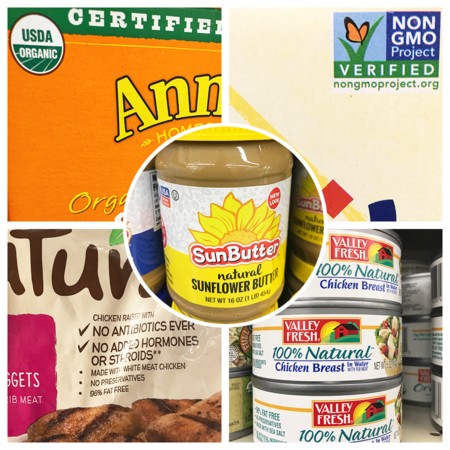The 6 most common food labels defined
Posted: 9/24/2018
 When you go to the grocery story, you’ll see hundreds of labels. All natural, non-GMO, organic, or local, we often have label over load. But what does it all really mean? Below, you’ll find a breakdown of the some of the most common labels we’ve seen in the grocery store.
When you go to the grocery story, you’ll see hundreds of labels. All natural, non-GMO, organic, or local, we often have label over load. But what does it all really mean? Below, you’ll find a breakdown of the some of the most common labels we’ve seen in the grocery store.
Organic – The label is regulated by the United States Department of Agriculture (USDA). Certified organic foods are grown and processed according to federal standards that address animal raising practices, pest and weed control and use of additives. However, it’s a common myth that certified organic foods don’t use pesticides or herbicides. Instead, non-synthetic versions of these products are allowed.1
Natural – This label is not regulated by USD or Food and Drug Administration (FDA). Generally the term is used to signify that nothing artificial or synthetic has been added to food, but does not address on farm practices.2
No Antibiotics – Labeling is regulated by Food Safety Inspection Service (FSIS). This label can be placed on foods if the farmer has provided appropriate documentation that the animals have never been given antibiotics.3 ALL food, with or without the antibiotic free label is free from antibiotics, as farmers must follow strict withdrawal period guidelines. The withdrawal period is the amount of time it takes for the antibiotic to leave an animals system. Meat is tested for residue at multiple steps in the process. 4 Antibiotics are an important tool for animal health and are prescribed by veterinarian.
No Hormones – This label is regulated by FSIS. The “No Hormones” label is approved for use on beef if appropriate documentation is provided. Estrogen levels in beef are minimally different in implanted beef (3 nanograms) versus non-implanted beef (2 nanograms) compared to an adult woman at 513,000 nanograms and an adult man at 136,000 nanograms.5 The “No Hormones” label is not approved for use on pork or poutry unless accompanied by "Federal regulations prohibit the use of hormones.” as hormones are not used in pork or poultry production.6
Local – This label is not regulated and does not have a commonly accepted definition.When purchasing, look to see if there are any standards as to how local is defined in store. Local means something different to each person, and could mean food from your county, state, or geographical region. Plus for some of us, like those of us in the Midwest, it’s impossible to find local fruits and vegetables during some seasons of the year.
Non-GMO –This is a voluntary food label and so it may look different on each package. Non-GMO labels are placed on foods that have GMO varieties, and those that do not have GMO varieties of food. Contrary to popular belief only 11 commercially produced foods have GMO varieties. These varieties often protect against pests and or weeds, allowing farmers to use less pesticides and herbicides. GMOs are generally recognized as safe by the scientific community.7It takes an average of 13 years and $136 million to bring a GMO crop to market8and new crops are regulated by the Environmental Protection Agency (EPA), FDA, and USDA.9
No matter the label, you can feel good about the food you feed your family. Labels are often a marketing tactic, so know what the label really means (if anything!) before you pay more. If you have questions, talk with your local farmers to learn how they raise the food you eat.
Tune in weekly to catch the Farmer's Daughter segment on KELO 107.9 FM or 1320 AM at 10am on Monday. Did you miss this week's radio segment? Listen to it now: 9.24.18 FD Food Labels.mp3
References
- https://www.usda.gov/media/blog/archive/tag/organic-101
- https://www.fda.gov/Food/GuidanceRegulation/GuidanceDocumentsRegulatoryInformation/LabelingNutrition/ucm456090.htm
- https://www.fsis.usda.gov/wps/portal/fsis/topics/food-safety-education/get-answers/food-safety-fact-sheets/food-labeling/meat-and-poultry-labeling-terms/meat-and-poultry-labeling-terms/!ut/p/a1/jZFRT8IwFIV_zR673jkkw7dliYEpm4QoZS-mg3ZbsrVLe3HBX2_RSNSAcPt0e7-Te3pKC8poofhbU3FstOLtoS_Gr7CAcTBJIM0nwT3MspdF_pAkEC1vHbD-B8jCK_VnKoZL-vSKBTdmnswrWvQca9IoqSmrBBKu7CCMpUxqvSWWS4F7IvkGia2FwO9By0vRNqqirBP8oNqSXu9aNPvjiKAwnb0MrGjx2y4E7syycDmaplkI-egvcCLPL-B8YC6RqtXl5-etY1WGkXu6EVIYYfydcdc1Ym_vPPBgGAa_dP78je48OCWotUXKfnK0757Z-2M8heapW0U2_gCHlBYx/#17
- https://www.fsis.usda.gov/wps/portal/fsis/programs-and-services/!ut/p/a1/tVRNT8MwDP0tHHrM4qztmnGrJiY2plZQvtoLStqkC1rTkgYG_HqyIdCEQIAYySGx8_z8bMnBBb7GhWYPqmZWtZqtNnYxuoFTGJHxBOZA3J4lfhYczxMfgqED5LuAdEymDnB5mp5MJkAT_7v4K1zgotS2s0ucy171qGy1Fdp6oNxptHC3hintgW07VfYeVMwyh1qtRLlRiZiukBFda6x7LJeiUb01Tx4Y0avqXqB31yZVx2pRuYdab61SVTgnLKCRHAeIy6FAQSAJ4pEskeBE8hGnFEJ4K_SLFcOPCv2mVa-Ar1PkTkO0k2TopM2S5GgRknAIxwRnvyzqA2G6iGKYTSGbZfQEgIb7Joz2TJgGfyWEMPIdYZqRc5gSSPfdw_T3PZz_YObU7d1dEbvJ2QzLo8XX_z06TlS9avn2S8hjzX1a48IIKYwwg3vj3Etru_7QAw_W6_WAK10Pyrbx4LOAZds7zbs43DUXDb2Vi9EZBT_sHp7PZdPcJAlinD75zwtxFR-8AFD0Wkc!/#NRP
- https://www.bestfoodfacts.org/hormones-in-beef/
- https://www.fsis.usda.gov/wps/portal/fsis/topics/food-safety-education/get-answers/food-safety-fact-sheets/food-labeling/meat-and-poultry-labeling-terms/meat-and-poultry-labeling-terms/!ut/p/a1/jZFRT8IwFIV_zR673jkkw7dliYEpm4QoZS-mg3ZbsrVLe3HBX2_RSNSAcPt0e7-Te3pKC8poofhbU3FstOLtoS_Gr7CAcTBJIM0nwT3MspdF_pAkEC1vHbD-B8jCK_VnKoZL-vSKBTdmnswrWvQca9IoqSmrBBKu7CCMpUxqvSWWS4F7IvkGia2FwO9By0vRNqqirBP8oNqSXu9aNPvjiKAwnb0MrGjx2y4E7syycDmaplkI-egvcCLPL-B8YC6RqtXl5-etY1WGkXu6EVIYYfydcdc1Ym_vPPBgGAa_dP78je48OCWotUXKfnK0757Z-2M8heapW0U2_gCHlBYx/#15
- https://www.nationalgeographic.com/people-and-culture/food/the-plate/2016/05/17/scientists-say-gmo-foods-are-safe-public-skepticism-remains/
- https://croplife.org/wp-content/uploads/pdf_files/Getting-a-Biotech-Crop-to-Market-Phillips-McDougall-Study.pdf
- https://fas.org/biosecurity/education/dualuse-agriculture/2.-agricultural-biotechnology/us-regulation-of-genetically-engineered-crops.html

Comments
blog comments powered by Disqus